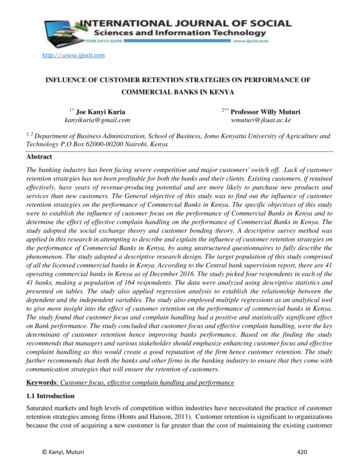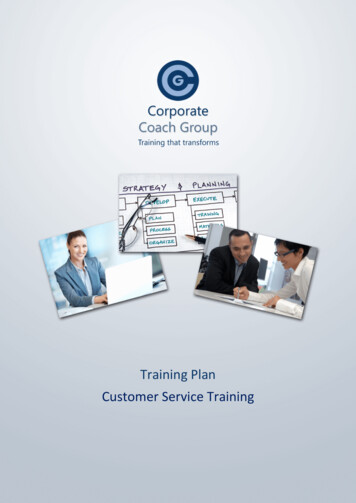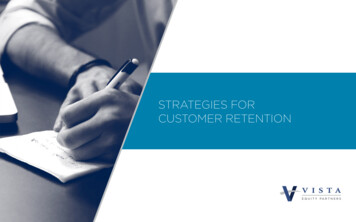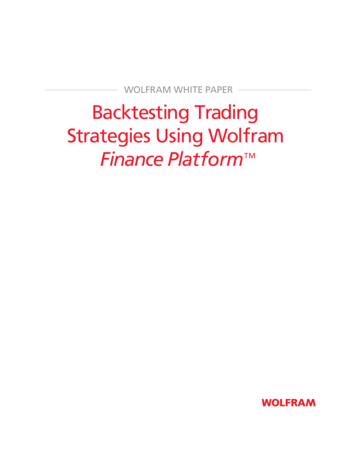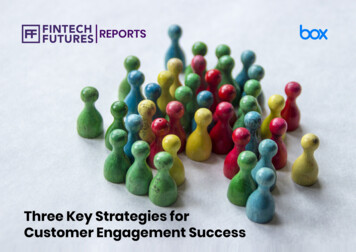
Transcription
FINTECH REPORTSFUTURESThree Key Strategies forCustomer Engagement SuccessThe New Decade of Core Banking: Challenges and Transformation 1
FINTECH REPORTSFUTURESIntroductionThe financial services landscape has experienced afundamental change in the last few years. Increasedregulation, thinning margins, the entrance of fintechs andstart-ups, and the interest of Big Tech firms have created aheady mix of challenges for banks at almost every level.However, the core services for customers remain largelythe same. Financial institutions are beginning to realise thatproviding exceptional customer experiences can be a truedifferentiator in the market.Customer service has emerged as one of the most highlyvalued attributes in a bank by consumers, while every pointdropped in a bank’s customer experience score can lead to upto 124 million lost.1The most forward-thinking of CEOs must be asking thequestion “what do my consumers really want from their bank?”.Yet that question often ends up simplifying things. Banks needto be asking “how can I understand what customers are tryingto achieve, and help them achieve it?”“Banks once relied upon reputation and pedigree to getthe job done, gain market share and build up the loyalty oftheir customer bases. Times have changed, and financialinstitutions are changing with it. Trust was once built on thebedrock of the branch. That rock has eroded away, creatinga more complex and competitive landscape where the bestbank wins.Financial institutions are facing increasing competitivepressure from new entrants, diversified needs of their youngercustomers, and a rapidly changing economic and sociologicallandscape. Pivoting to create better customer experience willbe crucial to ensuring future success.“In the past UI and CX were primarily activities that wereoutsourced to a third party company, as they were deemednon-core. Today financial services firms have extensive inhouse design teams, and delivering a great experience acrossall channels has become the epicentre of customer centricity.When I started out in the 90s user experience didn’t reallyexist as a discipline, we had graphic designers and technicalinformation architects, but those skills were really quite niche.Now when you’re developing a product UX and productdesign are absolutely mainstream.Reginald Warlop, group head of design,wealth and personal banking, HSBCKen Johnstone, chief product officer, Mettle by NatWest1Forrester, “Customer Experience Index 2019”, 2019 019-resultsThree Key Strategies for Customer Engagement Success 2
FINTECH REPORTSFUTURESNumber of pages in The Key Strategies1. Understand your CustomersIt should not come as a surprise that age plays a major role inthe difference among customer expectations and experiences.According to an Adobe survey of 1,500 US adults found that halfof adults aged under 35 would rather engage with a computerthan a human being.2“Windows 95manual3Windows 10Quick-Start Guide5Now consumers are reluctant to visit branches, with 26%saying they want to avoid face-to-face banking altogethergoing forward. Almost 80% of low and middle-incomeAmericans want more digital processes from the banks thatrepresent them, while 47% want more “touchless” banking.6The truth is that consumer’s digital needs have undergonea rapid and dramatic acceleration over the course of2020. Even prior to the arrival of the coronavirus, customerswere beginning to value digital banking experiences as amajor factor in their choice of financial institution. A surveyconducted by the Competition and Markets Authority (CMA)saw customer place three digital banks at the top for overallservice quality.4Ken Johnstone, Mettle8That has been compounded by the pandemic, which hasshifted operations into the digital space in an unprecedentedmanner. Relationship creation and retention was once centredaround the branch. It used to be all about someone shakingyour hand as you walk in the door, sitting you down andengaging a personal experience.Chatbots and artificial engagement are popular amongbrands because they enable interaction in real-time withcustomers. Yet the implementation of single-system solutionslike this don’t solve all problems. On top of this, young peopleare more likely to take action if they have a bad experiencewith a brand, in the form of telling friends, stopping purchases,or posting negative reviews.3What is the job the customer is trying to do? It’s less about takinga journey and refining that journey. It’s really about starting from ablank sheet of paper and saying ‘okay, if I want to get them up andrunning as quickly as possible, what are the minimum number ofsteps that can make them go through to achieve that goal.111While the sit-down relationship may be headed towardsextinction, there remains a handful of technologicalopportunities to require it. Differentiation through value-addedinsights into spending habits, financial management, planning,and transparent communication can all be built into a digitalfront -generations.html#gs.j69fqw3Microsoft, “Introducing Windows 95”, 1995 l.pdf4Ipsos, “Personal Banking Service Quality”, 2020 nkingservice-quality5Microsoft, “Quick Start: Your Desktop”, 2016 e9ef3-402e4258-a31f-0a023989d4f1.pdf?n Windows 10 Desktop ent-banksThree Key Strategies for Customer Engagement Success 3
FINTECH REPORTSFUTURES2. Utilise new technologyAfter all, consumers have made themselves clear: digital andremote services are not a temporary and makeshift solution; theylook to be the default state of play for now and the future. Theimportance of honing and improving on customer-facing digitalproducts and experiences is paramount.For corporate institutions and customers taking weeks to get upand running with their bank is no longer acceptable. Experiencedoesn’t have to focus on colourful user interfaces and flashygraphics but on meeting the fundamental needs of the customer.Great customer experience is about breaking down the bigquestions like “what do people want from their bank account oradvisor?” into specific segmented processes that keep customersawake at night, and then solving them. So how do banks go aboutthat? Through technology. Smaller companies have stolen theinitiative. They can focus on specific needs and develop a greatuser experience for a niche product or segment.“63% of bank users are opento trying out new digitalexperiences7Yet many financial institutions are burdened by back officesystems and infrastructure sometimes decades old. This makesrevamping customer engagement at scale a massive challengeat a time when three-quarters of bank operations leaders saythat customer experience is their top priority.882% expressed concerns aboutvisiting a bank branch duringthe COVID-19 pandemic7Financial institutions have increasingly turned to cloud-basedsolutions. Banks traditionally relied on their own datacentres,and a heavyweight technology footprint based in-house. Yetstoring and hosted data within the cloud offers an opportunity fordevelopment acceleration.The industry has become more fragmented. Now niche providersperfect [experiences] for a particular need, such as accountsfor teenagers or car loans. Customers have been more willing toembrace the fragmentation because mobile operating systemshave forced a fundamental alignment on CX.Whether it’s a music app or a hiking app, both will function in asimilar way. The same can be said for an app that provides a carloan, which means a sizeable barrier to adoption of “yet another app”has been removed.Reginald Warlop, HSBC7Economist Intelligence Unit, “Forging New Frontiers”, 2020 will-revolutionise-banking8Accenture, “Customer First Has Reached The Back Office”, 2018 https://www.accenture.com/t20180404T034452Z w /us-en/ ng-OperationsSurvey.pdf#zoom 50Three Key Strategies for Customer Engagement Success 4
FINTECH REPORTSFUTURESMeeting that need for acceleration are a host of Software-asa-Service cloud providers offering an ability to cover all but themost mission-critical of processes. The hosting giants competeto provide the fastest speeds, the best development times,and the most efficient monitoring systems. It’s estimated thatthose who utilise new technology like the cloud could see profitincreases of up to 40%.9“When you sign up for a long-term product you want to be assuredthat at the end of the digital journey, you’ve successfully signed up forwhat was originally offered. If the processing in the back end is partiallyaugmented with a human intervention to close the mapping gap with aback-end system, the customer is not impacted.Reginald Warlop, HSBCA shift in IT spending? Why banks move to cloudFlexiblepricingmodels3. Realign with collaborative toolsCustomer experience has become a greater focus of corporatestrategy. There’s no doubt there are executives deliberatinghow to commit their businesses to a full-scale transformationtowards it. Among their immediate concerns will be structuring theorganisation, and where to start.No need to pay to“keep the lights on”No infrastructureinvestment“Automation could take over between 10 and 25% of all work acrossbank functions in the near future.10 As manual processes becomeautomated, leaders in the market will seek to empower theirworkforce with new skills and responsibilities across the front officeand customer-facing functions.Embracing best-of-breed cloud solutions enables freedom fora financial institution to refocus itself on its core goal: meetingthe customer’s needs. A bank which embraces the cloud canadjust its expenditure in cash and manpower from runningdata centres and in-house technology maintenance and put ittowards creating market-leading products and services.Bigger banks have very diverse customer bases with very diverseneeds. So, making changes in one place can impact a different groupin a different way and it’s just more difficult. This is where the breakingout of different functions into different entities under one umbrellacan work. It’s a sensible kind of best of both worlds approach.Ken Johnstone, MettleCollaboration tools are crucial in the current climate. 84% of techexecutives consider collaboration tools important or missioncritical in 2020.11 As a result of the remote-first work environment, thefunctionalities needed include internal and external communication,simplified workflows, and secure remote -serve-customers-better11Box, “Collaboration in a Work-from-Anywhere World”, 2020 mtknxpz57wThree Key Strategies for Customer Engagement Success 5
FINTECH REPORTSFUTURESIn a world where consistent face-to-face collaboration is nolonger guaranteed, the ability to replicate processes digitallyis paramount. The uploading, editing, and sharing of financialdocuments online enables faster client onboarding andaccelerated processing of applications for products like loansand mortgages.The tools of the past restricted communication to text,rudimentary chat, and email. These often meant backand-forths between employees and clients, unnecessarytangential chains and hand-offs, and other problems bringingproductivity to a stuttering halt.Average time colleagues and customersexpect a response over email: One hour or less12Average response time for a business email:1 hour 52 minutes13Average response time to customers overemail: 12 hours 10 minutes14New software and services have emerged to answer theneed for rapid-fire resolutions. Tech firms have borne thebrunt of the need for quick and easy collaboration, their usagefigures surging by up to 30 ond-to-a-business-email14Super Office, “Customer Service Benchmark Report”, 2018 emand-during-covid-19“Innovation is part of it but innovation doesn’t always come fromwithin. You also have to leverage best-of-breed the way we runour business wouldn’t be possible without the tools we’re usingtoday, such as Box.Souheil Badran, COO, Northwestern MutualThree Key Strategies for Customer Engagement Success 6
FINTECH REPORTSFUTURES“When you used to buy a secondhand car it always involvedgoing to visit the seller yourself. Only recently are there fullyonline car buying platforms which deliver the car you want tobuy to your door – with the option to send it back right away.The same is true for mortgage applications, which are complex,multi-step journeys spanning many departments and includingexternal parties.The ability to share data and insights quickly and securely withclients and colleagues is a key factor in acquiring or reacquiringnew business. The importance of seamless collaboration acrossan organisation, internally and externally, between stakeholders,clients, accountants, customers, and corporates, cannot beunderstated.Digital collaboration applies to all segments of the financialservices sector. Commercial and corporate bankinginvolves multi-process onboarding cycles. Consultations,documentation, approval, training, testing, and go-live. All canbe shifted to an online environment, where securely hosteddocumentation can be viewed and edited by all parties.“Many of the steps are determined by regulations and it’stempting to approach any redesign of a mortgage journey asan evolution of the past. Challenger banks have less “legacythinking” and have been able to approach banking products likebooking a hotel, with some great innovation coming along theway. We’ve hired many non-bankers to bring new ideas – likeusing insights from the travel industry to create a totally newexperience to buy structured products online.The creation of central hubs like these can be used asengagement portals between customers and the institution.Connecting customers with their relevant representatives oninternal teams with a few clicks could drastically reduce costper customer, and slice onboarding time.CorebankingprocessesConnection of cloud-first toolsReginald Warlop, HSBCCreationof digitalcontenthubsReal-time collaborationExternal transparencyIntuitiveengagementfor customersThree Key Strategies for Customer Engagement Success 7
FINTECH REPORTSFUTURESConclusionsThe benefits of implementing superior customer experiencetouch upon all aspects of the bank. It can impact the bottomline in the boardroom and the satisfaction of front-line staff whointeract with customers daily in challenging times.By instigating a process through which they can understandtheir customer, embark on targeted technology improvements,and invest in collaborative technology, banks can tap into thebenefits on offer. This will result in a long-lasting competitiveadvantage and serve as a base through which to match andsupersede pressures from new entrants and technology firms.“As the industry comes to grips with the ramifications of theCOVID-19 pandemic, the fog has lifted on what is necessaryto achieve lasting success. The digital future is laid out beforefinancial institutions who must realign themselves to meet theupcoming needs of a digital workforce and customer base. Itcomes down to a matter of execution and selecting the righttechnology to use as a springboard into future innovation.The bar is definitely higher across the board. I think businesses andbanks are getting better in general, in line with customer expectations.When a user can jump into a new product and intuitively know how touse it, you know that problems are being solved.Ken Johnstone, MettlePower the bestexperiences foryour clientsSeamless collaboration with anyone, anywhereFrictionless security and complianceIntegrated with your best-of-breed appsStreamline work across your organization with BoxOnboard clients with ease.Accelerate loan processes.Attract new customers withtransparent client onboarding. Withour financial services compliantsoftware, you enable clients andinternal teams to share and accessconfidential information, assigntasks, sign documents, and editcontent from any device, anywhere.Reduce the overall turnaround timefor loan requests by connectingcustomers and underwriters ororiginators in an efficient, interactiveenvironment. A seamless financialcloud service makes it simple toupload documents and fuse themwith existing applications.Create great customerengagements.Easy online experiences attract newcustomers and help you build loyalty.With a rich set of APIs to createtailored experiences, you provideclients and financial advisors with amore effective and interactive wayto work.At Box, we know clients expect omni-channel experiences that are seamless every step of the way. So we make it easy fortoday’s leading financial services firms to speed up day-to-day tasks: onboarding, collaborating on loans, managing M&Aactivity, and accessing and exchanging updated financial information. With one place to securely manage all your content,you get total peace of mind — and your customers get the experience they deserve.Learn more at box.com/industries/financial-services.
FINTECH REPORTSFUTURESFINTECHFUTURESREPORTSAbout FinTech FuturesFinTech Futures is a digital publishing platform for theworldwide fintech community – from the industry veterans tothose just entering the space, and everyone in-between!We provide daily news, in-depth analysis and expertcommentary across a comprehensive range of areas.Our broad readership and solid reputation, combined with indepth coverage across fintech on a worldwide scale, makes usthe leading resource for technology buyers, sellers, developers,integrators and other specialists across the sector.Our website attracts nearly one million monthly pageviews and our daily newsletter is delivered to over 42,000 keydecision-makers in the financial services and technologysectors. The brand is active across the key B2B social mediaplatforms, with over 40,000 followers on Twitter @FinTechFutures and over 20,000 members in our LinkedIn groups.FinTech Futures Website: www.fintechfutures.comReports & SurveysSponsorshipopportunities areavailable for oursurveys andwell-researchedtopic-specificreports.Twitter: @FinTech FuturesLinkedIn: @fintechfuturesAbout the author:Alex Hamilton is deputy editor at FinTech Futures.He has been reporting on the financial technologysector for more than five years across a variety ofindustry publications and has written extensively ondigital transformation, cybersecurity, and enterprisetechnology. He holds a masters degree in ancienthistory from the University of Nottingham.He can be contacted at: alex.hamilton@fintechfutures.comVisit fintechfutures.com/reports-calendar for a full list of our reports in 2020TO REACH NEW PROSPECTS TALK TO:Jon RobsonSam HuttonHead of SalesBusiness Development ExecutiveEmail: ntechfutures.comThree Key Strategiesfor CustomerEngagement Success 9Tel: 44 (0)20 3377 3327Tel: 44 (0)20 7017 7017
Oct 11, 2020 · providing exceptional customer experiences can be a true differentiator in the market. Customer service has emerged as one of the most highly valued attributes in a bank by consumers, while every point dropped in a bank’s customer experience score can lead to up to 124 million lo





